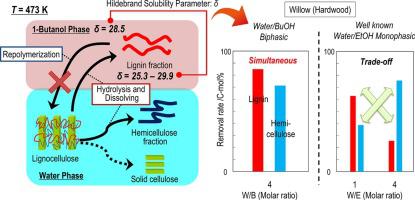Industrial Crops and Products ( IF 5.9 ) Pub Date : 2020-11-19 , DOI: 10.1016/j.indcrop.2020.113078 Yuki Kawamata , Takuya Yoshikawa , Yoshihito Koyama , Hiroya Ishimaru , Satoru Ohtsuki , Eri Fumoto , Shinya Sato , Yuta Nakasaka , Takao Masuda

|
Biphasic organosolv treatment for soft- and hardwood using water/1-butanol was unique based on the correlation between liquid-phase states and solubility of the co-solvents when compared with a monophasic water/ethanol system. First, Pro II process simulator showed that water/1-butanol exhibited a biphasic system in the range of 1.6–19.0 mol/mol at a treatment temperature of 473 K. In addition, solubility of the co-solvents was evaluated using the Hildebrand solubility parameter (δ), which indicated that the biphasic system could simultaneously provide 28.5 and 42.0 MPa1/2 for the 1-butanol and water phase, respectively. Each δ value appeared appropriate for lignin and hemicellulose dissolution because they were similar to those reported for lignin and a typical sugar. While hemicellulose could be removed by increasing water content in an organosolv of Japanese cedar sawdust, high lignin removal was achieved only under biphasic conditions. Carbon yield of each fraction (solid, 1-butanol-, and water-soluble fraction) and Py-GC/MS analysis revealed that lignin and hemicellulose could be recovered in the 1-butanol and water fractions, respectively. The organosolv using Japanese cedar and willow was compared to the results when using monophasic water/ethanol. The results indicated that the co-solvent could not efficiently remove hemicellulose and lignin simultaneously because the monophasic system did not produce the level of solubility needed under the same conditions. In contrast, the biphasic water/1-butanol system achieved greater removal of hemicellulose and lignin compared to water/ethanol. The biphasic system was also applicable to separation of an industrial agricultural waste; sugarcane bagasse. Finally, the 2D-NMR spectra of 1-butanol-soluble lignin showed a trace amount of β-O-4 linkages in the lignin, indicating β-O-4 was cleaved via hydrolysis in the water phase during biphasic treatment.
中文翻译:

水/ 1-丁醇助溶剂双相有机溶剂处理软木和硬木的独特性
与单相水/乙醇体系相比,基于液相状态与助溶剂溶解度之间的相关性,使用水/ 1-丁醇对软木和硬木进行双相有机溶剂处理是独特的。首先,Pro II过程模拟器显示在473 K的处理温度下,水/ 1-丁醇在1.6–19.0 mol / mol的范围内显示出双相体系。此外,使用Hildebrand溶解度评估了共溶剂的溶解度参数(δ),表明双相系统可以同时提供28.5和42.0 MPa 1/2分别用于1-丁醇和水相。每个δ值似乎都适合木质素和半纤维素的溶解,因为它们与报道的木质素和典型糖相似。虽然可以通过增加日本雪松木屑的有机溶剂中的水分来去除半纤维素,但只有在双相条件下才能实现高木质素去除。每个馏分(固体,1-丁醇和水溶性馏分)的碳收率和Py-GC / MS分析表明,木质素和半纤维素可以分别在1-丁醇和水馏分中回收。将使用日本雪松和柳树的有机溶剂与使用单相水/乙醇时的结果进行了比较。结果表明,助溶剂不能同时有效地去除半纤维素和木质素,因为单相体系无法在相同条件下产生所需的溶解度。相反,与水/乙醇相比,双相水/ 1-丁醇系统实现了更大的半纤维素和木质素去除。双相系统也适用于工业化农业废物的分离。甘蔗渣。最后,可溶于1-丁醇的木质素的2D-NMR光谱显示木质素中有痕量的β-O-4键,表明在双相处理过程中,β-O-4在水相中通过水解被裂解。双相系统也适用于工业化农业废物的分离。甘蔗渣。最后,可溶于1-丁醇的木质素的2D-NMR光谱显示木质素中有痕量的β-O-4键,表明在双相处理过程中,β-O-4在水相中通过水解被裂解。双相系统也适用于工业化农业废物的分离。甘蔗渣。最后,可溶于1-丁醇的木质素的2D-NMR光谱显示木质素中有痕量的β-O-4键,表明在双相处理过程中,β-O-4在水相中通过水解被裂解。



























 京公网安备 11010802027423号
京公网安备 11010802027423号